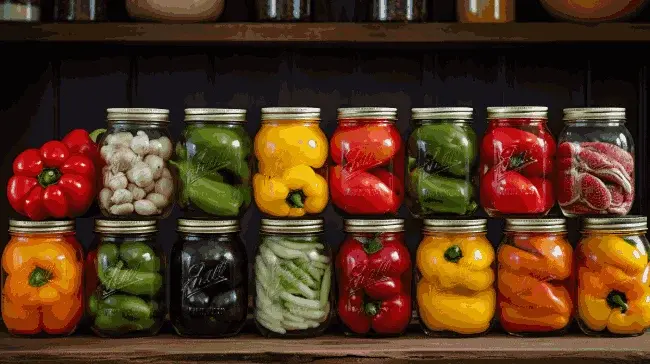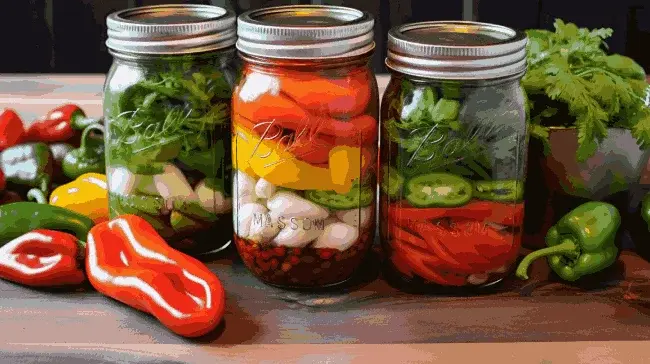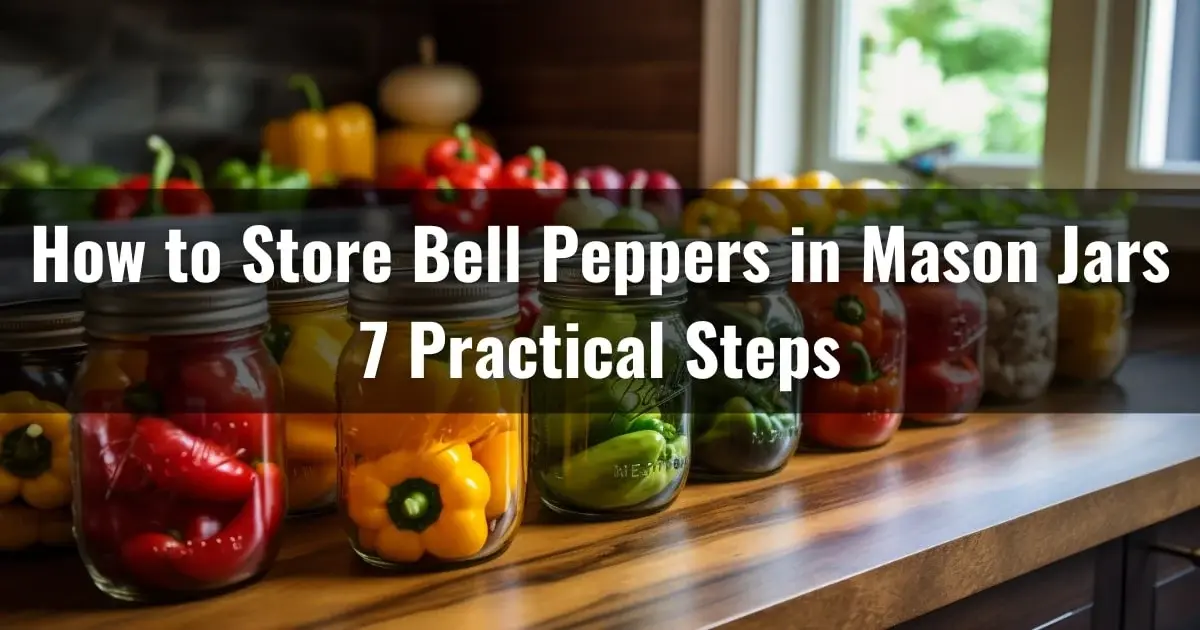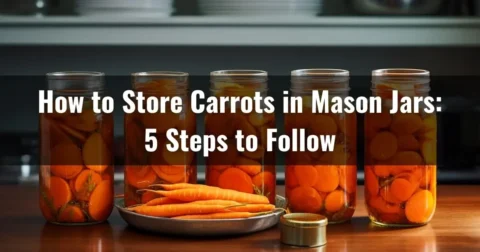Mason jars are a versatile and eco-friendly solution for bulk bell pepper storage, extending the shelf life of this vibrant and nutritious food. Even after harvesting many bell peppers or finding a great deal, you can keep them long in Mason jars.
But you need to know how to perfectly store bell peppers in mason jars so that you can eat them for a long time.
Prepare your fresh bell peppers by washing and removing any stems and seeds. Sterilize your mason jars to create a clean environment for storage. Slice the bell peppers and pack them into the jars, leaving some space at the top. Add a preservation solution, such as brine or vinegar, and seal the jars tightly.
Here, we’ll demonstrate the steps for storing bell peppers in mason jars, keeping them fresh and delicious for weeks. It’s time to use mason jars in your kitchen to preserve bell peppers like an expert.
Jump to Section
How Do You Store Bell Peppers in Mason Jars in Your Kitchen?

You don’t have to be an expert to store bulk bell peppers in mason jars, you just need to follow a few simple steps.
- Step 01: Preparing bell peppers
- Step 02: Sterilizing mason jars
- Step 03: Slicing and packing the bell peppers
- Step 04: Adding a preservation solution
- Step 05: Sealing the jars
- Step 06: Storage and labeling
- Step 07: Checking and using stored bell peppers
Let’s look at each step in more detail to ensure you get the best out of your bulk food storage (Mason Jar).
Step 01: Preparing Bell Peppers
To begin storing bell peppers in mason jars in your kitchen, we recommend gathering fresh, colorful, and firm peppers and rinsing them thoroughly. Use cold water and gently rub the peppers with your hands to ensure a thorough cleaning. Pay special attention to the crevices and stem area of the peppers.
Once rinsed, let the peppers dry completely. Moisture can lead to spoilage, so allow them to air dry or use a clean kitchen towel to pat them dry.
Step 02: Sterilizing Mason Jars
Carefully place the washed jars, lids, and rings into the boiling water, ensuring they’re completely submerged. Allow them to boil for 10-15 minutes. This boiling process will kill any bacteria or contaminants that may be present.
After the jars have been heated to the appropriate temperature, carefully lift them from the pot with tongs or jar lifters. Place them on a clean kitchen towel or a drying rack to air dry completely. Once the jars are dry, they’re ready to store your bell peppers.
Step 03: Slicing and Packing the Bell Peppers
To slice and pack the bell peppers, we strongly recommend carefully cutting them into your desired shapes and then placing them into the sterilized mason jars. You can slice them into ring strips or dice them, depending on how you plan to use them later. Make sure to remove the seeds and membranes before slicing.
When packing the peppers into the jars, be gentle to avoid crushing them. Leave some headspace at the top of the jar to allow for expansion without putting pressure on the lid. Overcrowding the peppers can lead to spoilage.
Step 04: Adding a Preservation Solution
Now, you’ll need to prepare your preservation solution for storing the bell peppers in mason jars in your kitchen. You can choose between a brine or an oil solution to do this.
For a simple brine, combine 4 cups of water with 1 tablespoon of salt in a pot and heat it until the salt dissolves. If you want to add extra flavor, we recommend including vinegar or citrus juice. Once the brine is ready, pour it over the sliced bell peppers in the mason jars, leaving about half an inch between them.
Alternatively, if you prefer oil, ensure the peppers are fully submerged to prevent spoilage.
Either way, adding a preservation solution will help preserve the flavor and extend the shelf life of your bell peppers.
Step 05: Sealing the Jars
After filling the jars with the peppers and preservation solution, it’s time to seal them.
The jars should be topped with sterilized lids. Ensure the lids are free from cracks or defects that could compromise the seal.
Then, secure the lids tightly by twisting the rings onto the jars. This will create an airtight seal, preventing any air from entering and spoiling your peppers. Give the lids a gentle tug to check if they’re properly sealed.
Step 06: Storage and Labeling
Label the Mason jars with the contents and dates of storage so you can easily identify and track the freshness of your bell peppers.
Indicating what’s inside the jars and the date they were stored is best done with a permanent marker or adhesive label. By doing so, you’ll be able to keep an eye on the bell peppers’ use-by dates and ensure you consume them before they spoil.
Also, organizing your jars with labeled contents will simplify the process of finding specific jars.
You can now store the labeled Mason jars in your pantry or cupboard in a cool, dark place. Avoid exposing them to direct sunlight or extreme temperatures, as this can affect the quality of the bell peppers. Take care to minimize excessive movement or shaking of the jars to maintain their freshness over time.
Step 07: Checking and Using Stored Bell Peppers

To ensure the quality of your stored bell peppers, regularly check for any signs of spoilage, such as mold or off odors. Ensure you inspect the peppers before using them in your recipes.
- Start by examining the jar for any visible signs of mold or discoloration. If you notice any, discard the entire jar immediately.
- Next, open the jar and take a sniff. If you detect any unpleasant or off smells, it’s best to throw away the peppers.
When using the stored bell peppers, we recommend consuming them within 2 to 3 weeks for optimal flavor and texture. While they may still be safe to eat beyond this timeframe, their quality may decline.
How Can You Extend the Life of Mason Jar Stored Bell Peppers?
To extend the life of bell peppers stored in mason jars, remember a few key points.
No 01: Cold Storage
You can keep mason jar-stored bell peppers longer by keeping them in cold temperatures. Cold storage, specifically in the refrigerator in your kitchen, significantly slows down the degradation process of the peppers.
The optimal temperature range for bell peppers in the refrigerator is around 40°F (4°C). Maintaining this temperature ensures that the peppers retain their vibrant color, firm texture, and delicious taste.
No 02: Vacuum Sealing
You can preserve the freshness of your peppers for longer periods by vacuum sealing them. The vacuum sealer sucks out all the air from the mason jars, preventing oxidation and slowing the growth of spoilage microorganisms.
To vacuum seal your bell peppers in Mason jars, simply place the peppers into the jars, leaving a bit of headspace, and then use the vacuum sealer to remove the air. Once sealed, store the jars in a cool, dark place in the kitchen to maximize their shelf life.
No 03: Rotate Stock
To prolong the life of mason jars stored with bell peppers, we recommend rotating your stock regularly. Practicing first-in, first-out (FIFO) rotation is crucial in ensuring the bell peppers are consumed within their optimal storage period.
When you use the oldest jars first, you prevent the bell peppers from sitting in the jars too long and spoiling. When rotating your stock, check the expiration dates on the jars and use the ones closest to expiring first.
FAQ’s: How to Store Bell Peppers in Mason Jars
1. How long do roasted peppers last in a mason jar?
In the fridge, you can expect roasted peppers to last in a mason jar for about 10 days and the freezer for up to two months. To store the roasted peppers, place them in the jar, ensuring they’re tightly packed. Seal the jar with the lid and place it in the fridge or freezer.
2. Can I store different-colored bell peppers together in the same Mason jar?
Mixing different-colored bell peppers in a Mason jar not only adds visual appeal but also allows you to enjoy a variety of flavors. When storing different-colored bell peppers together, following proper cleaning and packing techniques is essential to maintain their quality.
3. Can I store bell pepper seeds in Mason jars for planting in the future?

Storing bell pepper seeds in Mason glass jars helps protect them from moisture, pests, and temperature fluctuations, which can all affect their germination rate. To ensure the viability of the bell pepper seeds for future planting, store them in Mason jars with airtight lids and keep them in a cool, dark place.
Conclusion
Now you know how to store bell peppers in mason jars in the kitchen. Combining airtight seals, proper sterilization, and a cool, dark storage area helps you maintain quality and preserve the bell pepper’s flavor for later use.
Ensure that you rotate through and use your bell peppers before their shelf-life expires to enjoy the full flavor of fresh, quality produce. Also, save the seeds in another mason jar if you plan on growing them for future use.
So, stock up on bell peppers, store them in Mason jars, and enjoy the vibrant colors and flavors whenever you use them.




